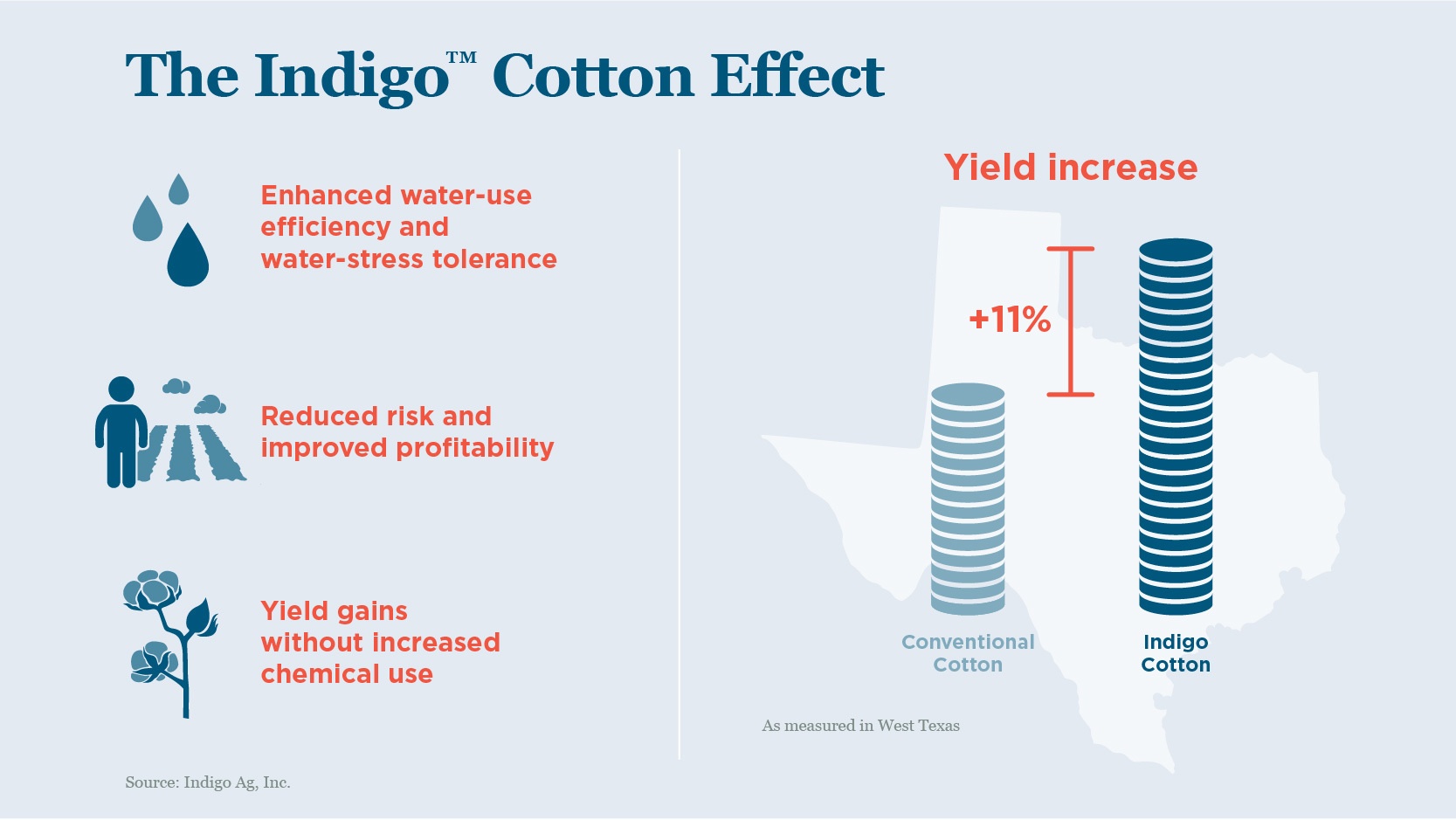- Indigo™ Cotton demonstrated an average yield improvement of 11% in the target environment of West Texas
- Farmers experienced productivity gains in diverse growing conditions without increased use of water or agricultural chemicals
- Novel R&D platform and economic proposition enable continuous innovation in cotton and other crops
Boston, Massachusetts, January 9, 2017 - Indigo, a company dedicated to harnessing nature to help growers sustainably feed the planet, announced preliminary data from its first commercial product, Indigo™ Cotton. Launched in the spring of 2016 on approximately 50,000 acres across multiple states, Indigo Cotton is a seed treatment based on naturally occurring, in-plant microbes (endophytes). Indigo Cotton has been developed to help increase water use efficiency, with the goal of improving yields when plants are growing under water stress.
The data represent grower experiences in diverse environments and were presented at the Beltwide Cotton Conference by Dr. Gregory Sword, a professor of entomology at The Texas A&M University and Indigo collaborator. Data collected to date show that Indigo Cotton led to a 11% average yield increase in West Texas. The state has experienced moderate to severe water stress this growing season1. Despite this, yield improvements were achieved without increased water or chemical use, confirming that Indigo Cotton can help protect crops in areas of water scarcity. Indigo also commercialized its product on a variety of seed types in other areas. The most successful combination of seed type and microbial treatment achieved a peak performance above 15%.
Indigo Cotton’s win rate was high, at 75% and consistent across a variety of seed types and geographies. In the agriculture industry, the win rate is the percentage of growers’ fields in which the treated crop outperformed the non-treated crop.
The data are consistent with the results of four years of controlled field trials. They inform Indigo’s 2017 product selection, as the company identifies the most effective combination of microbial treatment, seed variety, and other conditions.
“These results represent another promising step in what we hope will be the next significant innovation in agriculture,” says David Perry, CEO and Director of Indigo. “One of the advantages of Indigo’s unique partnership model with growers is that we can gather this type of data from commercial fields, which helps us to improve applications of the plant microbiome, in cotton and other crops, in years to come.”
With the global population expected to grow to 9.7 billion by 20502, the demand for water is increasing steadily and dramatically while resources are becoming scarce. As agricultural production accounts for 70% of current global water consumption3, innovative water efficient methods of food production are critical.
“Indigo has transformed a promising discovery into a product that can perform at scale to deliver substantial yield increases on modern commercial farms,” says Dr. Gregory Sword, of Texas A&M AgriLife Research. “The application of the plant microbiome to agriculture represents a naturally derived solution that works to address today’s environmental stresses, with the potential to dramatically improve long-term agricultural sustainability.”
PIONEERING A NEW PLATFORM THAT ACCELERATES INNOVATION AND AN EVIDENCE-BASED PRICING MODEL
Optimizing the plant microbiome, Indigo is introducing a new way for agricultural products to be discovered and developed. The core of Indigo’s innovation is a computational biology platform that identifies beneficial microbes and brings naturally derived products to market in less than three years, compared to an average of ten to fifteen years to commercialize traditional biotech and chemical products.
These beneficial microbes are extensively tested in laboratory assays, greenhouse trials, and field trials to identify the best candidates. Once commercialized, the products are further assessed in diverse conditions, in partnership with growers, with the results continually refining Indigo’s algorithms. Products can be improved each year after they are first commercialized. This approach overcomes the limitations of testing agricultural products in controlled trials only.
Indigo is also pioneering a new business model that shares risk and reward with growers, with the goal of improving farmer profitability. One of its key principles is to determine the value of the product based on the productivity gain realized by the grower, creating a new economic proposition for the agriculture community. Traditionally, individual growers are asked to pay a premium upfront for new technologies, regardless of the outcome at the end of the season.
For more information, watch the video that features Indigo CEO David Perry, H2H Farms Cotton Producer Shawn Holladay, and Texas A&M professor Dr. Gregory Sword.

Interested in understanding more about Biological products? Learn more about Indigo Biologicals and biotrinsic™ here.
ABOUT THE INDIGO COTTON LAUNCH
Indigo launched Indigo Cotton in the spring of 2016 on approximatively 50,000 acres. Approximately 40,000 acres were planted in West Texas with remaining acres planted in four nearby states in collaboration with more than 70 growers. 21 locations planted untreated checks to enable a direct comparison of efficacy. Indigo Cotton was applied to a variety of seed types, across different geographies and growing conditions. Yield increase was determined by comparing the treated crop to the untreated check. The data presented today represent all of the cotton ginned to date from these comparisons.
To learn more about Indigo Ag, visit our about page.
REFERENCES
| [1] Brad Rippey, U.S. Department of Agriculture (December 27, 2016). United States Drought Monitor. |
| [2] United Nations, Department of Economic and Social Affairs, Population Division (2015). World Population Prospects: The 2015 Revision, Key Findings and Advance Tables. Working Paper No. ESA/P/WP.241. |
| [3] OECD (2016). Water Use in Agriculture. www.oecd.org/agriculture/wateruseinagriculture.htm. |
MEDIA CONTACT
| Indigo Natacha Gassenbach ngassenbach@indigoag.com |
Indigo Lauren Ashbrook lashbrook@indigoag.com |
Bloom for Indigo Katja Schroeder + 1 (646) 757-6116 indigo@bloompr.com |






